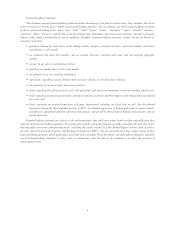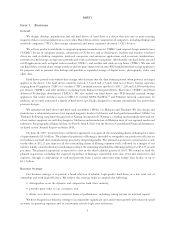Western Digital 2007 Annual Report Download - page 18
Download and view the complete annual report
Please find page 18 of the 2007 Western Digital annual report below. You can navigate through the pages in the report by either clicking on the pages listed below, or by using the keyword search tool below to find specific information within the annual report.Competition
We compete primarily with manufacturers of hard drives for use in desktop, notebook, enterprise, CE and external
storage products. Our competitors in the hard drive market include ExcelStor Technology, Fujitsu Limited, Hitachi
Global Storage Technologies, Samsung Electronics Incorporated, Seagate Technology and Toshiba Corporation. In
2006, Seagate completed the acquisition of Maxtor Corporation which, at the time of the acquisition, was one of the hard
drive industry’s four largest suppliers.
The hard drive industry is intensely competitive, with hard drive suppliers competing for sales to a limited number
of major customers. Hard drives manufactured by different competitors are highly substitutable due to the industry
mandate of technical form, fit and function standards. Hard drive manufacturers compete on the basis of product quality
and reliability, storage capacity, unit price, product performance, production volume capabilities, delivery capability,
leadership in time-to-market, time-to-volume and time-to-quality, service and support, and ease of doing business. The
relative importance of these factors varies by customer and market. We believe that we are generally competitive in all of
these factors.
We believe that there are no substantial barriers for existing competitors to offer competing products. Therefore, we
believe that we cannot differentiate WD hard drive products solely on attributes such as storage capacity, buffer size or
time-to-market. Accordingly, we differentiate WD by focusing on operational excellence, high product quality and
reliability, and designing and incorporating into our hard drives desirable product performance attributes. Such
performance attributes include seek times, data transfer rates, intelligent caching, failure prediction, remote diagnostics,
acoustics, error recovery, low operating temperature, low power consumption and optimized streaming capabilities. In
addition, we emphasize non-product related attributes, including rapid response to our customers. Rapid response
requires accelerated design cycles, customer delivery, production flexibility and timely service and support, which
contribute to customer satisfaction. We also rely on the strength of the WD brand name with value-added resellers,
retailers and solution providers to whom we sell our hard drive products directly and indirectly. We believe that trust in a
manufacturer’s reputation, its execution track record and the establishment of strategic relationships have become
important factors in the selection of a hard drive, particularly in a rapidly changing technology environment.
Advances in magnetic, optical or other data storage technologies could result in competitive products with better
performance or lower cost per unit of capacity than our products. High-speed semiconductor memory could compete
with our hard drive products in the future. Semiconductor memory is much faster in some applications than magnetic
hard drives, but currently is not competitive from a cost standpoint. Flash memory, a non-volatile semiconductor
memory, is currently much more costly and, while it has higher “read” performance attributes than hard drives, it has
lower “write” performance attributes. Flash memory could become competitive in the near future for applications
requiring less storage capacity than that provided by hard drives. We believe that the traditional high-volume computing
markets will remain the domain of 3.5-inch and 2.5-inch hard drives based on the HDD industry’s attributes of
reliability, availability and cost.
For an additional discussion of risks related to competition, see Item 1A of this Annual Report on Form 10-K.
Service and Warranty
We generally warrant our newly manufactured hard drives against defects in materials and workmanship from one
to five years from the date of manufacture depending on the type of product. Our warranty obligation is generally limited
to repair or replacement of the hard drive. We have engaged third parties in Australia, Brazil, Canada, China, Germany,
Hungary, India, Korea, Russia, Singapore, Thailand and the United Arab Emirates to provide various levels of testing,
processing and/or recertification of returned hard drives for our customers. In addition, we process, test and recertify
returned hard drives at our facility in the United States.
Manufacturing
We believe that we have significant know-how, unique product manufacturing processes, execution skills and
human resources to continue to be successful and have the ability to grow, as necessary, our manufacturing operations. To
be competitive, we must manufacture high quality hard drives with industry leading time-to-volume production at
competitive unit costs. We strive to maintain manufacturing flexibility, high manufacturing yields, reliable products,
12
























